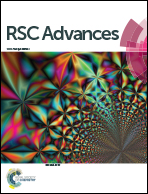Overcharging, thermal, viscoelastic and hydration properties of DNA–gelatin complex coacervates: pharmaceutical and food industries†
Abstract
DNA (CDNA = 5 × 10−3% (w/v)) and Gelatin A (GA) (CGA ≥ 0.1% (w/v)) exhibit disproportionate binding and form a variety of complex coacervates. The presence of charge neutral DNA–GA intermolecular soluble complexes was observed at CGA = 0.1% (w/v) while for higher GA concentrations the existence of polarity reversed and overcharged complexes was noticed. In this work, we observed an interesting behaviour of coacervates which showed varying mechanical properties of complex coacervates on overcharging while their thermal properties remain invariant. Rheological studies revealed neutral coacervates (formed of charge neutral complexes) possessed maximum storage moduli, which decreased by a decade with overcharging as CGA was increased to 0.25% (w/v). Raman data complemented rheological findings and suggested that in neutral coacervates structured water, 3200 cm−1 O–H band, was excluded from the coacervate matrix owing to dense packing of complexes, which was regained in overcharged coacervates (formed of overcharged complexes) due to repulsion acting between positively charged complexes. Small angle neutron scattering data revealed that correlation length ξ increased from 1.27 to 1.90 nm as the complexes become overcharged and the geometrical shape of the constituent complexes, determined from the low-q region, showed the presence of diffusion limited aggregates. Rheological characterization attributed anomalous gel-like features and the Cole–Cole plot description implied the presence of heterogeneity in these materials. The interesting phenomenology shown by this system has a good potential for gene therapy and modulating the physical properties of gelatin based items in food industries.


 Please wait while we load your content...
Please wait while we load your content...